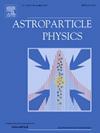宇宙γ射线通量在日全食期间减少的确切证据:2009年7月22日印度日食的观测
IF 2.9
3区 物理与天体物理
Q1 ASTRONOMY & ASTROPHYSICS
引用次数: 0
摘要
在过去的四分之一世纪里,人们已经做了许多尝试,以观察在日全食期间低能γ射线通量预期的倒高斯减少,与日全食点一致。然而,这些研究产生了不同的结果。在这里,我们提出了一个实验装置,优化宇宙γ射线收集,同时尽量减少地面干扰。利用四个大体积NaI(Tl)闪烁探测器,我们在印度印多尔和西里古里两个不同的地理位置收集了2009年7月22日日全食期间的γ射线通量数据。这些探测器被置于地面之上,以进一步减少地面γ射线对信号的污染,从而能够在这些地点测量日食之前、期间和之后的通量。尽管进行了精心的设置,但在日食期间,雨中不同程度的氡子体使光谱分析变得复杂。为了解决这个问题,我们开发了一种基于roofit的方法,该方法结合了指数函数和高斯函数来生成统一的能谱,考虑了时间变化和降雨的影响。此外,我们开发了一种新的方法来从降雨引起的干扰中分离出真实背景,结果显示两个地点在日全食期间γ射线通量减少了~ 6%。本研究在实验设置、建模、数据分析等方面有所改进,为今后日全食实验奠定了基础。本文章由计算机程序翻译,如有差异,请以英文原文为准。
Definitive evidence of cosmic γ-ray flux reduction during solar eclipse totality: Observations from the 22 July 2009 eclipse in India
Over the past quarter century, many attempts have been made to observe an expected inverted Gaussian decrease in the low-energy -ray flux during total solar eclipses, coinciding with the point of totality. However, these studies have produced varied results. Here, we present an experimental setup optimized for cosmic -ray collection while minimizing terrestrial interference. Using four large-volume NaI(Tl) scintillation detectors, we collected -ray flux data during the total solar eclipse of 22 July 2009 from two geographically distinct locations in India: Indore and Siliguri. The detectors were elevated above the ground to further reduce signal contamination by terrestrial -rays, enabling the measurement of flux before, during, and after the eclipse visible from these sites. Despite the careful setup, varying levels of radon daughters in the rain during the eclipse period complicated the spectral analysis. To address this, we developed a RooFit-based method that combines exponential and Gaussian functions to generate unified energy spectra, accounting for temporal variations and the effects of rain. Furthermore, we developed a novel method to isolate the true background from rain-induced interference, revealing a 6% reduction in -ray flux during totality at both sites. With improvements in the experimental setup, modelling, and innovative data analysis, this study establishes a foundational approach for future total solar eclipse experiments.
求助全文
通过发布文献求助,成功后即可免费获取论文全文。
去求助
来源期刊

Astroparticle Physics
地学天文-天文与天体物理
CiteScore
8.00
自引率
2.90%
发文量
41
审稿时长
79 days
期刊介绍:
Astroparticle Physics publishes experimental and theoretical research papers in the interacting fields of Cosmic Ray Physics, Astronomy and Astrophysics, Cosmology and Particle Physics focusing on new developments in the following areas: High-energy cosmic-ray physics and astrophysics; Particle cosmology; Particle astrophysics; Related astrophysics: supernova, AGN, cosmic abundances, dark matter etc.; Gravitational waves; High-energy, VHE and UHE gamma-ray astronomy; High- and low-energy neutrino astronomy; Instrumentation and detector developments related to the above-mentioned fields.
 求助内容:
求助内容: 应助结果提醒方式:
应助结果提醒方式:


